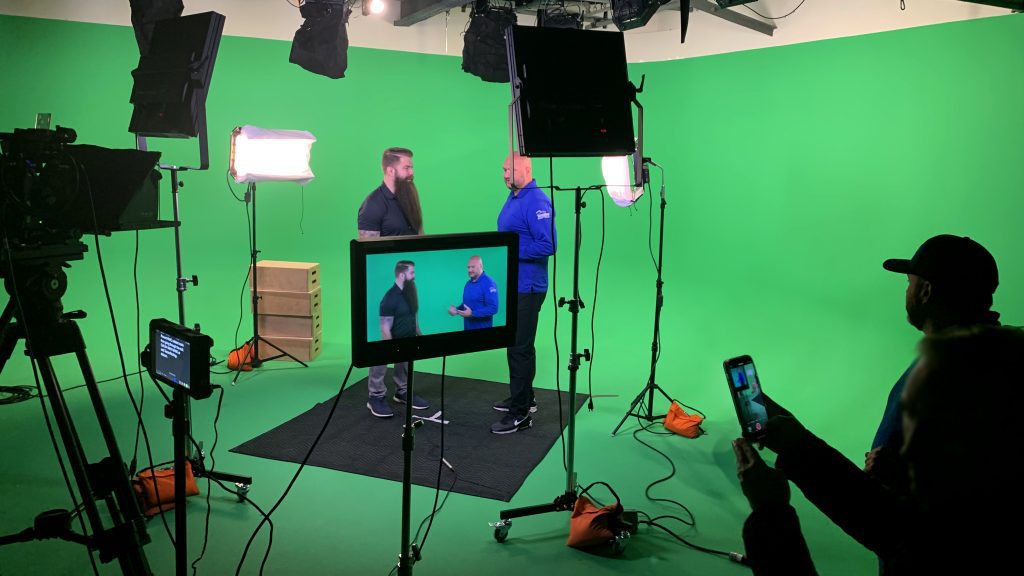At this point, we all know that your digital presence and footprint correlates with business success – with video content standing out as a formidable tool for engagement and conversion. Videos do not just tell a story; they create an emotional connection with the audience, transforming viewers into loyal customers. Insights from industry leaders, Tim Hebel and Ethan Bell from Beanstalk Web Solutions, a web design company in St. Louis, reveal that leveraging video effectively can lead to significant enhancements in user engagement and ROI. Our intent at Outreach Studios is to ensure our clients excel by using videos optimally, as their success reflects ours as well. Dive into proven strategies and expert insights that underscore the pivotal role of video in online business dynamics.
The digital landscape underscores the importance of immediate, impactful communication, and video content offers precisely that. With a staggering 87% of marketers attesting to the positive ROI from video marketing, businesses are keen to adopt this medium. But, effective video utilization goes beyond just placing a clip on a webpage. It involves strategic integration that aligns with brand messaging, enhances the user experience, and encourages interactions that drive conversions.
From captivating product demonstrations to trust-building testimonials, the diversity of video types available can meet various business objectives. Furthermore, as Tim Hebel points out, “Videos aren’t just a value-add; they’re becoming essential.” This necessity drives brands to think innovatively about how they embed videos within their digital platforms. Through this article, we unravel the strategies that help brands navigate the complexities of video placement and usage, offering insights that are backed by success stories and industry data.
So whether you aim to enhance your homepage’s engagement with a visually compelling story or seek to optimize your product pages for better conversion rates, the answers lie in understanding and executing the best video practices. Our exploration will equip you with the knowledge to make informed decisions about video usage, ensuring that your video strategy not only captivates your audience but also drives tangible business results. Continue reading to unlock the potential of video on your website, guided by the experiences and wisdom of leading experts in the field.

Importance of Video in Today’s Digital World
The Ubiquity of Video Content
The digital landscape has vastly transformed the way businesses interact with their audiences. Video, in particular, has emerged as a powerful tool for engagement and connection. According to recent statistics, an overwhelming 98% of marketers consider video to be a critical component of their marketing strategy, with 87% expressing satisfaction with the return on investment generated by their video content.
This growing significance of video is reflected in the sheer amount of time users spend engaging with video content. On average, viewers watch 18 hours of online videos each week, underscoring the vast potential for businesses to capture audience attention and drive action through strategic video implementation.
Advantages of Using Video on Websites
Videos have become an integral element of effective digital marketing strategies, primarily due to their ability to significantly enhance user engagement and conversion rates. For instance, adding a video to a landing page can boost conversion rates by up to 18%. This substantial increase in engagement can be attributed to video’s unique ability to communicate complex information quickly and memorably, thus influencing purchasing decisions. Moreover, videos on social media are shared 12 times more than images and text combined, demonstrating their effectiveness in expanding brand reach.
Tim Hebel of Beanstalk Web Solutions shares an insightful perspective, noting, “Integrating video content effectively on your site not only enriches the user experience but also acts as a catalyst for conversions and customer retention.” It’s evident that in today’s competitive digital environment, videos are not just a complementary addition but a fundamental component of website strategy.
Effective Video Content Strategies



Creating Engaging Video Content
At the heart of a successful video strategy lies the creation of content that resonates deeply with its viewers. Ethan Bell of Beanstalk Web Solutions underscores this point, stating, “The key to effective videos lies in their ability to capture the audience’s emotions and convey the brand’s personality.” This sentiment echoes the broader industry understanding that emotionally engaging videos are more likely to inspire action, leave lasting impressions, and ultimately drive business outcomes.
Creating such content requires a careful balance of storytelling, visualization, and message consistency. Outreach Studios focuses on these elements by employing a comprehensive storyboard process, ensuring each video is tailored to communicate its client’s specific goals. [Infographic showing key elements of engaging video content: visual storytelling, emotional connection, brand alignment]
Diverse Video Types for Various Goals
- Product Demonstrations: These videos are crucial for showcasing how a product works in real time, providing clarity and building consumer trust .
- Customer Testimonials: Personal testimonials provide real-world proof and build credibility by showing potential customers how others have benefited from a service or product. [Link to a testimonial video example]
- Behind-the-Scenes Footage: Offering a glimpse behind the curtain can humanize brands and establish a personal connection with the audience. It highlights transparency and builds trust .
- Explainer Videos: These are ideal for breaking down complex topics into digestible, engaging content, offering viewers a clear and concise understanding of key concepts.
Strategic Placement of Videos on Websites



Homepage and Landing Pages
The homepage and landing pages serve as the introduction to a business’s digital presence, making the placement of high-quality video content crucial. Integrating a compelling video here has been shown to quickly engage visitors and reduce bounce rates significantly. Videos can immediately capture attention and communicate key messages more effectively than text alone. Well-placed videos on landing pages can set the tone for a user’s entire site experience, emphasizing the importance of carefully considering where these videos are positioned. [Diagram showing optimal video placement on a homepage]
Product or Service Pages
Video content on product or service pages can provide in-depth insights into what is being offered, which in turn increases understanding and fosters consumer confidence. The impact of such video integration is profound, with Tim Hebel emphasizing that “videos aren’t just a value-add; they’re becoming essential.” Statistics support this, showing that using videos on these pages can enhance product understanding and result in a 73% increase in conversion rates. This underscores the necessity for strategic video placement to maximize consumer engagement and conversion potential.
Testimonials and Case Study Segments
The inclusion of video testimonials within a website’s structure can significantly bolster perceived authenticity and trust. By showcasing real customer experiences and outcomes, brands can build credibility with prospective clients. According to recent statistics, video testimonials are particularly effective because they provide personal insights that resonate on an emotional level, lending a persuasive edge over traditional text testimonials. This strategic use of testimonials not only humanizes the brand but also reinforces trust and reliability.
SEO and Technical Considerations
Optimizing Videos for Search
For videos to truly shine in search results, they need to be optimized with care and strategic forethought. Crafting SEO-friendly descriptions and titles is crucial; they should be concise, descriptive, and include relevant keywords that mirror user search queries. Additionally, providing transcripts for your videos is crucial. Not only do transcripts improve accessibility, but they also provide search engines with text to crawl, improving your video’s SEO performance significantly. Other best practices to consider include ensuring the video is hosted on a platform that supports SEO, such as YouTube or a similar service, and embedding the video prominently on a page dedicated to its content theme. Finally, utilization of schema markup can help search engines understand the content of your video and its relevance.
Loading Times and Accessibility
Optimizing video content doesn’t stop at improving search visibility; it must also ensure swift loading times and broad accessibility. Videos should be compressed without losing quality to ensure quick loading times, a factor that directly influences bounce rates and user satisfaction. Including features like closed captions not only enhances accessibility for users with hearing disabilities but also extends reach to non-native speakers and users in sound-sensitive environments. A checklist to optimize video content accessibility includes providing adjustable playback speeds, ensuring keyboard accessibility, and using high-contrast visuals for those with visual impairments. By implementing these strategies, businesses can improve user experience and ensure their video content reaches a wider audience.
Measuring the Impact of Video Content



Key Performance Indicators to Monitor
Effective measurement is crucial for understanding how video content performs and impacts business objectives. Key Performance Indicators (KPIs) such as view count, engagement rate, and conversion rate play a central role in this process. View count provides an initial overview of a video’s reach, indicating how many times it has been watched. Engagement rate, which includes metrics like likes, shares, and comments, helps gauge how well the content resonates with viewers. Conversion rate is particularly vital, as it reveals how many viewers took a desired action after watching the video, such as making a purchase or signing up for a newsletter.
Tools and Techniques for Video Analytics
Utilizing advanced analytics tools can provide deeper insights into video performance, enabling data-driven decisions to enhance content strategy. Google Analytics and YouTube Insights are among the most widely used tools, offering comprehensive data on viewer demographics, traffic sources, and viewing behaviors. These tools can track how long viewers watch a video, which segments are most popular, and drop-off points, helping marketers refine their content for better engagement. Additionally, leveraging these analytics can aid in optimizing videos for SEO, ensuring they reach the right audience effectively .
Embracing Video for Maximum Impact
In today’s digital landscape, integrating video into your website strategy is essential for staying competitive and engaging effectively with your audience. Video content not only enhances the user experience but also drives engagement and boosts conversion rates. By adhering to best practices, such as optimizing videos for search, strategically placing them across your platform, and leveraging analytics to measure their impact, businesses can maximize their return on investment and achieve greater marketing success.
Drawing from the insights shared by industry experts like Tim Hebel and Ethan Bell, the importance of tailoring video content to align with brand messaging and audience needs cannot be overstated. These practices ensure that not only is the content engaging, but it also prompts actionable outcomes. As the video landscape continues to evolve, staying informed about the latest trends and technologies will empower businesses to harness the full potential of video, transforming viewers into loyal customers and advocates.

